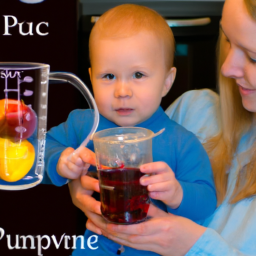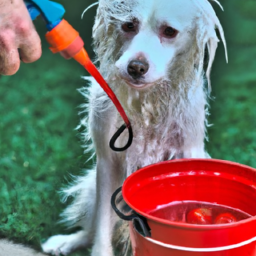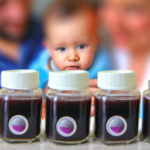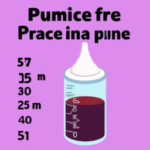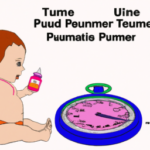As a parent of a toddler, I understand how important it is to maintain my child’s digestive health. Adding prune juice to their daily routine can help relieve constipation in young children. However, it can be difficult to know how much prune juice is safe for a two-year-old to consume.
For example, my friend’s child was struggling with constipation and their pediatrician recommended prune juice as a natural remedy. However, my friend was unsure of how much to give her child and whether it was safe for a young toddler. This is a common concern among parents.
In this article, we will explore the recommended dosage of prune juice for two-year-olds, the potential risks of overconsumption, and other natural laxative alternatives to consider.
Key Takeaways
- Prune juice can be an effective natural laxative for constipation in young children, but overconsumption can lead to health implications such as diarrhea, abdominal cramps, and dehydration.
- The recommended dosage for two-year-olds is around 2-4 ounces per day, and it’s important to start with a small amount and gradually increase if necessary.
- To prevent any digestive discomfort, prune juice can be diluted with water in a 1:1 ratio.
- Other natural laxative alternatives for relieving constipation in children include pear, apple, and white grape juice.
Understanding the Benefits of Prune Juice for Children
Prune juice can be a lifesaver for parents of constipated toddlers, as it helps ease their discomfort and get things moving down there. It’s a natural laxative that can help promote healthy bowel movements in children.
Prune juice benefits are aplenty, and it’s not just limited to constipation relief. It’s also a good source of vitamins and minerals, including vitamin C, potassium, and iron. These are essential nutrients that help support your child’s growth and development.
Aside from its nutritional value, prune juice health effects are also notable. It can help reduce the risk of certain diseases, such as heart disease and cancer. It’s also been shown to improve gut health by increasing the amount of good bacteria in the gut. This can lead to better digestion and a stronger immune system.
With all these benefits, it’s no wonder why prune juice is a popular choice for parents looking for a natural way to keep their child healthy. Now, let’s move on to the recommended dosage for two-year-olds.
Recommended Dosage for Two-Year-Olds
At 2 years of age, toddlers should only consume a limited amount of prune juice to avoid any potential health risks. The recommended dosage for two-year-olds is around 2-4 ounces per day. It is important to note that this amount should be included in their overall fluid intake for the day, and not exceed it.
To help you visualize the recommended dosage, I have created a table below that outlines the age-appropriate intake of prune juice for children.
| Age Range | Daily Intake |
|---|---|
| 6-12 months | 1-2 ounces |
| 1-2 years | 2-4 ounces |
| 2-5 years | 4-6 ounces |
| 6+ years | 6-8 ounces |
It is crucial to stick to the recommended dosage to prevent any adverse effects on your child’s health. In the subsequent section, we will discuss potential risks of overconsumption of prune juice.
Potential Risks of Overconsumption
Excessive intake of prune juice can pose health risks for toddlers, making it important for parents to be aware of potential dangers and monitor their child’s consumption. While prune juice is known for its digestive benefits, overconsumption can lead to health implications such as diarrhea, abdominal cramps, and dehydration.
As a result, parents should limit their child’s intake to avoid these potential risks. It’s important to note that while prune juice can help with constipation, it should not be used as a remedy for chronic digestive issues without consulting a healthcare provider.
In addition, parents should be mindful of their child’s diet and ensure that they are getting enough fiber and fluids to promote healthy digestion. With proper monitoring and moderation, prune juice can be a helpful addition to a toddler’s diet.
In the next section, we will discuss the signs of constipation in children and how to address them.
Signs of Constipation in Children
As a parent, it can be concerning when your child is experiencing constipation. Understanding the symptoms of constipation in children can help you identify the issue early on and take action.
One potential solution is introducing prune juice, but it’s important to know when and how much to give to avoid potential risks.
Understanding the Symptoms
When your little one is experiencing digestive issues, it’s important to understand the symptoms so you can find the appropriate solution. As a parent, it’s understandable to feel worried when your child is experiencing discomfort, but it’s important to stay calm and observe their behavior. Some common symptoms of constipation in children include infrequent bowel movements, hard stools, abdominal pain, and straining during bowel movements. If you notice any of these symptoms, it’s important to take action to prevent further discomfort.
One way to prevent constipation in children is by ensuring they have a healthy and balanced diet that includes plenty of fiber-rich foods. Encouraging your child to drink plenty of water and engaging them in physical activity can also help promote regular bowel movements. However, if your child is already experiencing constipation, there are various treatment options available. These include over-the-counter stool softeners, laxatives, and suppositories. It’s important to consult with a healthcare professional before administering any medication to ensure it’s appropriate for your child’s age and weight. Knowing when to introduce prune juice can also be an effective solution, which we will discuss in the next section.
Knowing When to Introduce Prune Juice
You may be wondering about the perfect time to introduce a natural remedy that can help relieve your child’s constipation. It’s important to note that introducing prune juice to your child should only be done at an age-appropriate timing. It’s usually safe to introduce prune juice to your child when they’re around 6 months old, but it’s always best to consult with your pediatrician before doing so.
If your child isn’t ready for prune juice yet, there are other alternatives you can try. You can increase their fiber intake by introducing more fruits and vegetables into their diet, or even incorporating whole grains into their meals. You can also increase their water intake to help alleviate constipation.
Remember, every child is different, so it’s important to find what works best for your child’s individual needs.
When considering prune juice as a remedy for your child’s constipation, there are a few precautions to take before giving it to them.
Precautions to Take Before Giving Prune Juice
Before giving prune juice to your 2-year-old, it’s important to take precautions to ensure their safety and comfort. Here are some things to keep in mind:
-
Start with a small amount: It’s recommended to start with just 1-2 ounces of prune juice and gradually increase the amount if necessary. Too much prune juice can cause diarrhea and upset stomach in young children.
-
Check for allergies: Even though prune juice is generally safe for most children, it’s always a good idea to check for food allergies before introducing a new food or beverage into their diet. You can do this by giving a small amount and watching for any adverse reactions.
-
Dilute with water: To prevent any digestive discomfort, you can dilute the prune juice with water in a 1:1 ratio. This will also help your child stay hydrated.
Taking these precautions can help ensure that your child safely enjoys the health benefits of prune juice.
Now that you’re aware of these, let’s move on to how to prepare prune juice for your little one.
Preparing Prune Juice for Your Child
Now that we’ve discussed the precautions to take before giving prune juice to your child, let’s move on to preparing the juice itself. As a parent myself, I understand the importance of finding safe and effective remedies for constipation in children.
While prune juice is a proven natural laxative, there are other juice alternatives that you can consider if your child doesn’t like the taste of prune juice. Pear, apple, and white grape juice are all great options that can help relieve constipation in children.
When it comes to introducing solids to your child, it’s important to do so gradually and with caution. Make sure your child is ready for solids and start with small amounts of pureed fruits and vegetables. You can also add foods that are high in fiber, such as whole grains, to help prevent constipation.
It’s important to remember that every child is different and may react differently to certain foods, so it’s always best to consult your pediatrician before making any major changes to your child’s diet.
In addition to prune juice and juice alternatives, there are other natural laxative alternatives that you can consider for your child. Let’s explore these options in the next section.
Other Natural Laxative Alternatives
If your child dislikes prune juice, there are other natural laxative options available. Pear, apple, and white grape juice are all good alternatives that can help with constipation. Additionally, incorporating fiber-rich snacks like whole grains and pureed fruits and vegetables can also aid in digestion and promote regular bowel movements.
To ensure your child stays hydrated, it’s important to offer fluids regularly throughout the day. Encourage your child to drink water and limit sugary drinks like juice and soda. By incorporating these natural laxatives and hydration tips, you can help your child maintain regular bowel movements and alleviate constipation.
In the next section, we’ll discuss the importance of incorporating fiber-rich foods in your child’s diet.
Incorporating Fiber-Rich Foods in Your Child’s Diet
You can easily incorporate fiber-rich foods into your child’s diet by offering a variety of high fiber snacks that are both delicious and nutritious.
Some kid-friendly fiber sources include fresh fruits like apples, berries, and pears, as well as vegetables like carrots, broccoli, and sweet potatoes.
You can also introduce whole grains like oatmeal, quinoa, and brown rice into your child’s meals. These foods not only provide essential nutrients, but also help to regulate your child’s digestion and prevent constipation.
In addition to offering fiber-rich foods, it’s important to encourage your child to drink plenty of water throughout the day. Dehydration can cause constipation, so ensuring that your child is well-hydrated can help to keep their digestive system functioning properly.
By incorporating these healthy habits into your child’s routine, you can help them maintain a healthy lifestyle and promote optimal digestion.
Maintaining a Healthy Lifestyle for Your Child
Encouraging a balanced diet and regular exercise can help your child maintain a healthy lifestyle and prevent chronic health issues. As a parent, I understand the importance of providing my child with healthy snacks and meals.
I make sure to include a variety of fruits, vegetables, and whole grains in his diet. I also limit processed and sugary snacks, opting for homemade options like trail mix or fruit and yogurt parfaits.
In addition to a healthy diet, I encourage outdoor activities to keep my child active. We love going for walks, playing at the park, and riding bikes together.
Not only does it promote physical activity, but it also allows us to spend quality time together as a family. With so many distractions like screens and technology, it’s important to prioritize outdoor playtime to support their overall health and well-being.
Frequently Asked Questions
Can prune juice cause allergic reactions in children?
As a parent, I understand your concern about prune juice allergies in children. Symptoms may include hives, itching, and difficulty breathing. Prevention is key, so introduce small amounts and monitor for reactions. Treatment may include antihistamines or epinephrine. Prune juice also has nutritional benefits for toddlers.
How often should prune juice be given to a two-year-old?
As a caregiver, I understand the struggle of managing a two-year-old’s constipation. Frequency recommendations for prune juice vary, but it’s important to consider alternative remedies such as increased fluid intake and fiber-rich foods. Consultation with a healthcare provider is recommended.
What are some common side effects of prune juice in young children?
As a parent, it’s important to know the potential side effects of prune juice in young children. While it can be effective for constipation prevention, it’s recommended to limit daily intake to avoid diarrhea or stomach discomfort.
Is it safe to mix prune juice with other liquids or foods?
Mixing prune juice with other liquids or foods is safe and can actually enhance digestion benefits. However, it’s important to remember that too much prune juice can lead to diarrhea. Consult with a pediatrician before incorporating it into your child’s diet.
Can prune juice interact with any medications a child may be taking?
It is important to talk to your child’s doctor or pharmacist about any potential drug interactions before giving them prune juice. They can also provide dosage recommendations based on the child’s age and health status.
Conclusion
In conclusion, introducing prune juice to your child’s diet can be like a gentle breeze that helps them ease through their bowel movements. But, it’s important to stick to the recommended dosage and keep an eye out for any signs of constipation or discomfort.
As a parent, it’s natural to want to make sure your child is healthy and happy. By incorporating fiber-rich foods and natural laxatives like prune juice into their diet, you can help them maintain a healthy digestive system. However, don’t forget to also encourage physical activity and a balanced diet overall.
With these tips and precautions in mind, you can help your child stay comfortable and regular.
Ilana has been a vegan for over 10 years. She originally made the switch for health reasons, but soon found herself becoming more and more passionate about the ethical and environmental implications of a vegan lifestyle. Ilana is the author of The Graceful Kitchen, a blog all about veganism. She loves to cook up delicious and nutritious vegan meals, and share her recipes with others who are interested in leading a cruelty-free life. Ilana is also a strong advocate for using whole foods as the foundation of a healthy diet, and believes that going vegan is one of the best ways to achieve this.
